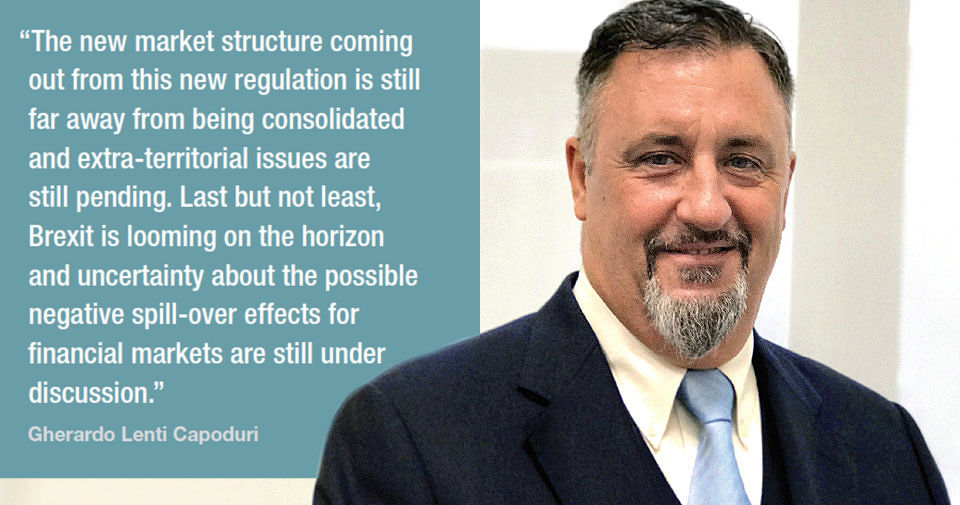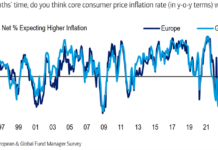Beige:
MIFID II: Gaps still exist in best execution
Despite the best efforts of regulators, buy-side trading desks will need to be careful in their application of best execution rules. Gherardo Lenti Capoduri, Head of Market Hub at Banca IMI explains why.
How clear is the objective of ‘best execution’ legislation for investors and has it been achieved?
The objective of best execution legislation is to increase investor protection, transparency and competition across financial markets. Best execution was already a point of attention under MiFID I; but with MiFID II, the concept has been deeply revised: there is much more emphasis now in the new directive and regulation in changing buy-side and sell-side obligations to demonstrate best execution when receiving, transmitting and executing client orders, with a more focused quantitative approach. In particular, RTS 27 and RTS 28 require trading venues, systematic internalisers (SIs) and investment firms to publish, in a readable format, data relating to the quality of execution. First reports must be published in April and June 2018 (with reference to 2017 data). In addition, investment firms will have to adopt a fairness of price policy, and also will be required to disclose the top five execution brokers and trading venues by volume on an annual basis. Data availability in a standardised and readable format will be a key focus for understanding the quality of these reports. These new rules have the ambitious target to extend MiFID I concepts also in the over-the-counter (OTC) fixed income world, even if the types of analytics are not largely transferable from the equity market.
If you contrast current requirements with the historical requirements, what has changed for buy-side traders?
Under MiFID I, investment firms were obliged to take “all reasonable steps” to achieve the best possible results for their clients. Under MiFID II, investment firms instead are required to take “all sufficient steps”. The slight change in the wording of the obligation implies that firms may have to make changes to current execution practice and policy, suggesting a more quantitative and formalised approach to demonstrate best execution.
When putting the mandated best execution reports together, as for RTS 27 or RTS 28, investment firms must consider different factors: price, costs, speed, likelihood of execution and settlement, size, nature of the order and any other relevant consideration. What has changed is that the “traded price level” is still relevant but it is no longer central to a best execution process model. Best execution under MiFID II consists of a process rather than a simple price discovery. This is particularly evident for the illiquid and OTC space where best price does not necessarily prove best execution: it only proves “not worst execution”.
What does that mean for trade execution?
Investment firms have now to establish clear procedures to monitor the minimum standards to demonstrate best execution, when executing client orders as per the execution policy rules. Consequently, since the introduction of MiFID II, we witnessed a shift from OTC/voice trading towards a more electronic executing model with more focus on creating an efficient ‘straight-through automatic processing’ which may better support the monitoring and reporting of best execution, as well as navigating in this new fragmented liquidity world. This shift is particularly evident for smaller tickets, while block-size tickets are still mainly traded OTC/voice. The role of SIs will be key to support this change, when the SI regime is in place. A consequence of that is a rebalancing of the traditional client-sales-trader workflow towards more agency broker models and the implementation of hybrid execution models trying to aggregate, in several creative ways, different protocols, different market models, and different types of client orders. This is more effective for regional investment banks than for global houses.
If transparency has not yet increased under MiFID II, when will that change?
Even with all of the preparatory work that took place since 2011, and the introduction of the new directive on 3rd of January 2018, there are still some further steps needed in 2018, for example, best execution reporting and the SI regime. The industry worked tirelessly in the last months of 2017 to be compliant with the new MiFID II rules. Nowadays, the financial services industry is working at full speed to complete the implementations and the final technical solutions.
The new market structure coming out from this new regulation is still far away from being consolidated and extra-territorial issues are still pending. Last but not least, Brexit is looming on the horizon and uncertainty about the possible negative spill-over effects for financial markets are still under discussion.
These changes are not going to affect the financial markets in the short term. We should see the first structural changes and increased transparency towards the end of this year. Technological innovation and fintech, which are already giving a boost towards more efficiency and decreasing operational costs, will help.
How has your engagement with clients altered as a result of this?
Sell-side and buy-side firms are still facing challenges as post-trade transparency data are still not available in a readable and standardised format. The ESMA report on liquid/illiquid instruments raises doubts over the effectiveness of the new regulations and data reliability, because only 221 bonds have fallen into the liquid category.
There is still some ambiguity over the definition of ‘Traded on a Trading Venue’ (TOTV); there is not yet a golden source or a public register for either SI or trading venues and finally, building a pan-European consolidated tape is still quite far away and its technical implementation is still under discussion.
Sell-side firms should adopt a more partnership-business relationship with the buy side, focusing more on ‘compliant services’, providing data and fulfilling mandatory obligation requirements.
Is your product/service set likely to change in the coming year?
Regulation and technological innovation have been the main drivers for any change in the execution model in recent years and they probably will play a key role in the future also. As a consequence of that, products and services will definitely change in the coming year: we are in a middle of a transformation, with impacts across the value-added chain for investment firms and in revenue-generating processes. A new trading culture needs to be established and the sell side, buy side, vendors and markets have to work together to build a new trading model, with possible changes of roles for participants and new entrants.
What does an asset manager need to consider to best serve their investor client under the current best execution regime?
An asset manager’s execution desk will most likely move towards a “multi-asset” model. Its main focus will be on creating an execution process based on best execution first, then on best price, in order to best serve their investor clients under the new best execution regime. Help in managing a more complex world might come from transaction cost analysis (TCA) tools. Buy-side firms will either develop these new tools internally or outsource them to third-party providers. TCA tools per se are not necessary in providing best execution under MiFID II; however, they can improve the overall quality of execution for a buy-side multi-asset desk to avoid reputational risk for failing to comply with new rules. TCA practices are already well established in the equity and forex worlds, but not yet in fixed income where a lack of data and instrument illiquidity are pushing towards a synthetic approach using proxies and benchmarking.
Sell-side firms will be expected on one hand to feed the pre-trade models and the TCA tools of large asset managers in a machine-readable and standardised way in order to help them to manage new complexity. On the other hand, in the case of small asset managers, the outsourcing of best execution to a short list of brokers might be a better choice for the future, because they might better aggregate fragmented liquidity, providing cutting-edge technological connectivity solutions and MiFID II compliant services.
©Markets Media Europe 2025













